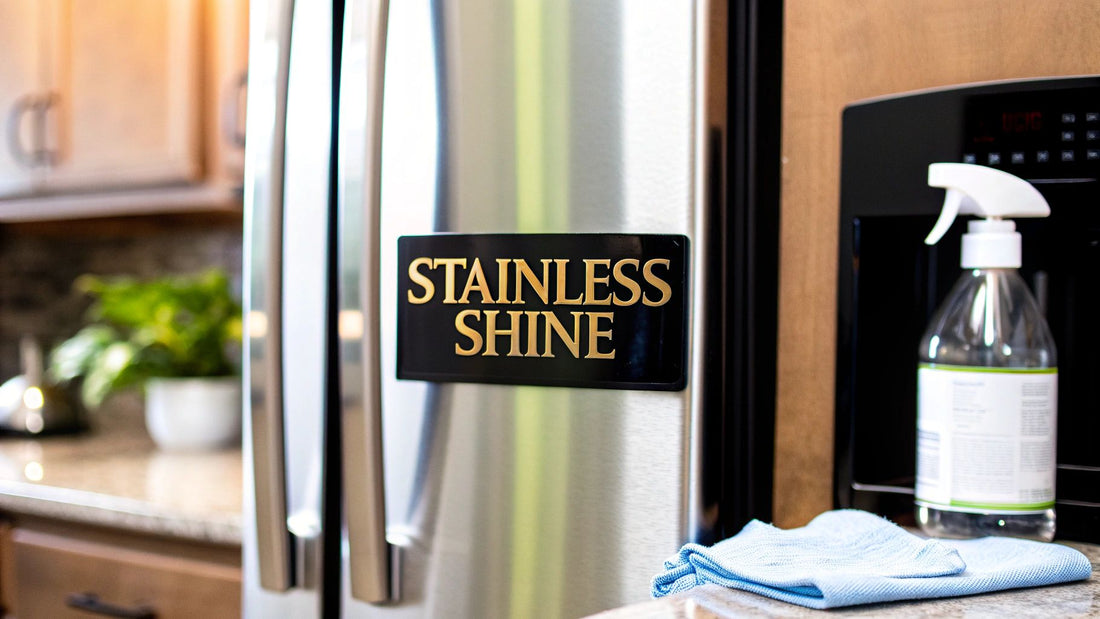
How to Clean the Stainless Steel Refrigerator Door Easily
Share
The secret to a gleaming stainless steel refrigerator door isn't some expensive, miracle cleaner. It really comes down to three simple things: a gentle cleaning solution, wiping with the grain of the steel, and drying it completely. For most everyday smudges and fingerprints, you can get a perfect, streak-free shine with just a microfiber cloth and a bit of warm, soapy water.
This isn't just about making things look good; it's about maintaining the high standards of hygiene that every professional kitchen lives by and staying informed on the best practices for restaurant equipment and supplies.
Your Guide to a Spotless Commercial Refrigerator
In the controlled chaos of a commercial kitchen, the state of your equipment speaks volumes. A grimy, fingerprint-covered refrigerator door can instantly detract from the professional image you've worked so hard to build. Forget just wiping it down—let's walk through the actual techniques the pros use to get that flawless, mirror-like finish every single time.
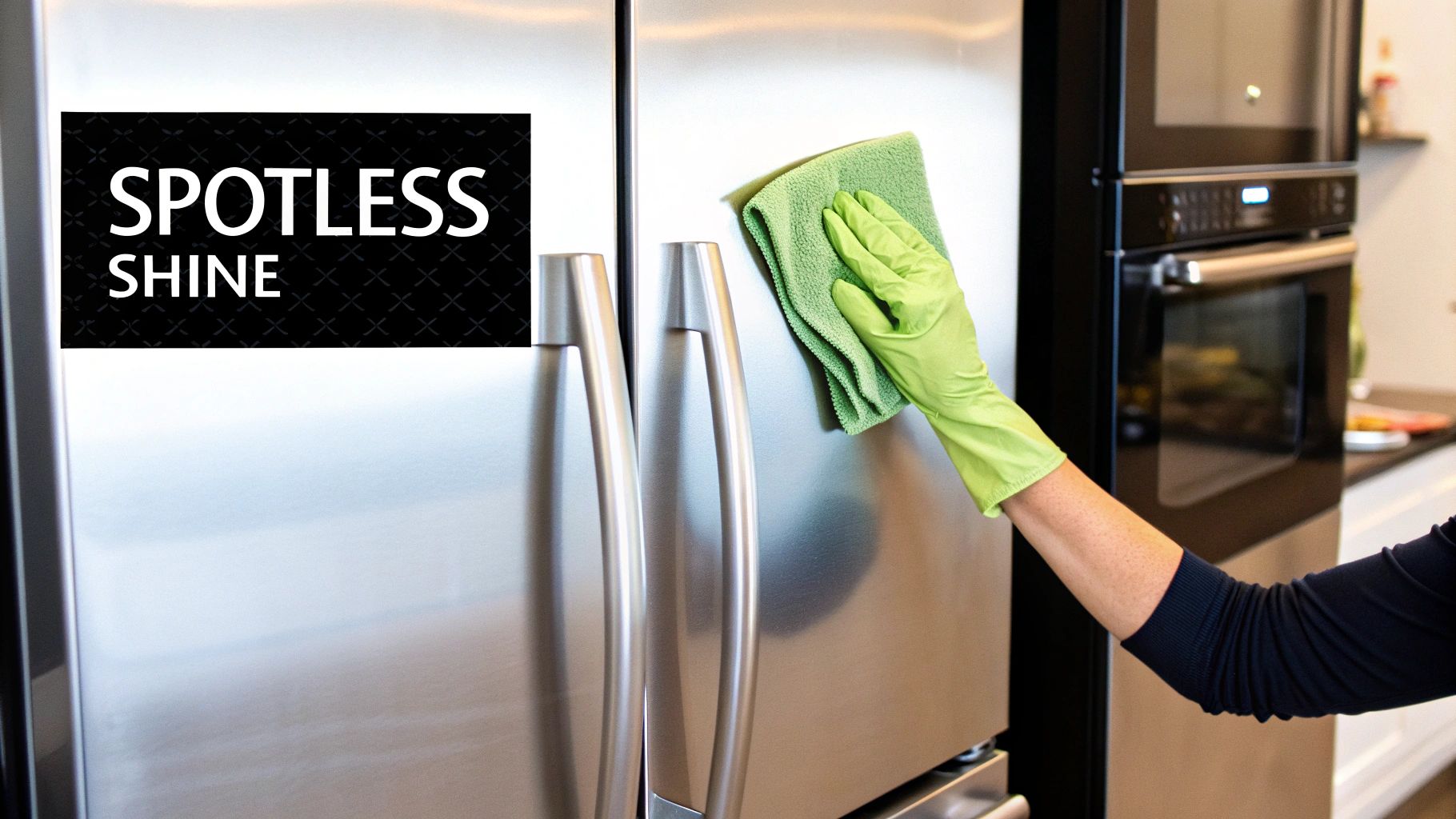
We'll get into why picking the right tools is crucial for protecting the surface and what you can do to keep it looking new. It’s all about enhancing that professional kitchen aesthetic, which tells everyone—from your staff to your customers—that you’re serious about quality. Follow our tips to stay current with industry trends and keep your kitchen looking sharp.
Why Proper Cleaning Matters
If you own a restaurant, you know a spotless kitchen is non-negotiable. It's about more than just appearances; it's about your reputation and meeting health codes. Both health inspectors and discerning customers notice the small stuff. A pristine stainless steel surface is a clear sign of cleanliness and high standards.
This isn't a new concept, either. Stainless steel became the go-to material for appliances for a reason. By the 1950s, over 90% of new refrigerators had stainless steel elements, prized for their durability and ease of cleaning. You can learn more about the long history of these appliances from KitchenAid.
Keeping your stainless steel equipment in top condition is a direct reflection of your kitchen's operational standards. It’s a small task that makes a big impact on both your staff and your patrons' perception of quality.
To make this as straightforward as possible, here's a quick reference table.
Quick Guide to a Streak-Free Clean
This table breaks down the essentials for a quick, effective clean without any fuss.
| Item | Purpose | Best Practice |
|---|---|---|
| Microfiber Cloths | For gentle cleaning and buffing | Have at least two on hand: one for washing, one for drying. |
| Warm, Soapy Water | To cut through grease and grime | A few drops of mild dish soap in a bowl of warm water is perfect. |
| The "Grain" Test | To avoid scratching the surface | Look closely at the steel to find the direction of the lines. Always wipe with them, not against them. |
Following these simple steps ensures your equipment always looks its best, reflecting the professionalism of your entire operation.
Choosing The Right Cleaning Supplies
Before you even touch that stainless steel door, let's talk about your toolkit. Getting this part right is half the battle. If you grab the wrong stuff, you can end up with permanent scratches or a weird discolored finish—a costly mistake, especially when you've invested in high-end equipment for your restaurant.
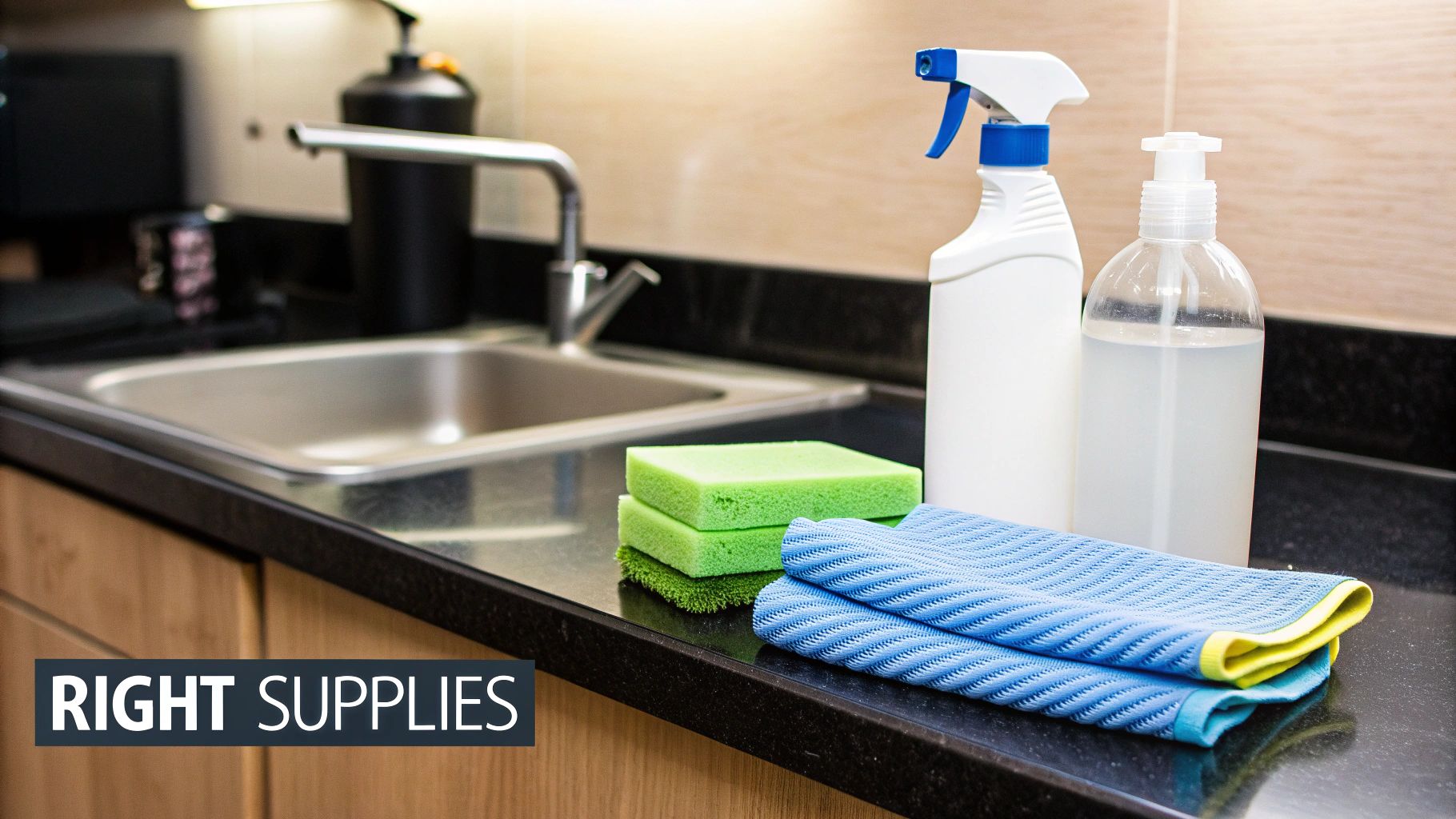
The first thing you need is a stack of microfiber cloths. Seriously, don't even think about using paper towels. They fall apart, leave lint everywhere, and can cause micro-scratches over time. Microfiber, on the other hand, is built to grab onto dirt and soak up moisture without harming the finish. I always recommend having at least two cloths handy: one for the actual cleaning and a second, dry one for buffing away any streaks.
Everyday Cleaners Versus Commercial Solutions
For the daily wipe-down of fingerprints and minor smudges, you often don't need anything fancy. A simple mix of warm water with a few drops of pH-neutral dish soap works wonders. Here's a pro-tip: if your restaurant has hard water, swap the tap water for distilled. It'll save you the headache of dealing with mineral spots and streaks later.
Of course, a high-traffic commercial kitchen is a different beast. You're going to need something with more muscle. When you're shopping for a commercial stainless steel cleaner, the most important thing to check is that it's food-safe, especially if the fridge is anywhere near a prep station. These cleaners are designed to cut through stubborn grease and often leave behind a protective film that helps repel future fingerprints.
This mindset of using the right tool for the job applies to all your equipment. For example, just as you'd select a specific stainless steel cleaner, you should also be using the right ice machine cleaners and sanitizers to keep things safe and compliant. You can find more info on that here: https://encoreseattle.com/blogs/seattle-restaurant-equipment/ice-machine-cleaners-and-sanitizers
It’s all about finding the right balance. A gentle, homemade cleaner is perfect for daily upkeep, but you need a heavy-duty commercial product in your arsenal for the inevitable kitchen grime.
If you really want to bring back that factory shine, especially on older or heavily used equipment, you might want to look into a specialized metal polish for stainless steel and chrome. These polishes do more than just clean; they can actually help restore the finish and keep your appliances looking their best.
How to Get That Perfect Streak-Free Finish
Alright, you've got your supplies ready. Now for the part that really matters: the technique. Getting that flawless, factory-fresh shine on your stainless steel fridge isn't about scrubbing harder—it's about working smarter.
The whole secret comes down to one thing: the grain. Seriously. Look closely at your refrigerator door, and you'll see very fine lines running either up and down or side to side. That’s the grain. Always, always wipe in the same direction as those lines. Working against them is the number one cause of streaks and even tiny scratches.
Prep the Surface First
Before you even think about your cleaning solution, give the door a quick once-over. Just take a clean, damp microfiber cloth and wipe everything down. All you're doing here is getting rid of any loose crumbs, dust, or sticky residue. This keeps you from accidentally grinding gunk into the steel's finish when you start the real cleaning.
Many of the same principles for getting a perfect shine apply across different surfaces. For instance, the techniques used in professional glass cleaning for streak-free results—like using the right cloth and ensuring no residue is left behind—are incredibly relevant here.
Now, grab your cleaner of choice. Whether you're using simple soapy water or a dedicated stainless steel spray, apply it to a fresh microfiber cloth, not directly onto the appliance. Spraying the door itself leads to drips and an uneven application. Putting it on the cloth gives you complete control.
This level of care makes sense when you think about it. The global kitchen appliances market was valued at around $43.1 billion back in 2020, and with 70% of us saying appearance is a huge part of why we buy a certain model, keeping it looking good is a priority.
The Clean, Rinse, and Buff
With your cleaner-dampened cloth, wipe the door, following the grain. Use long, even strokes from one end to the other.
Next, you need to rinse away any leftover cleaning solution. Don't just let it air dry. Grab another clean cloth, dampen it with plain water, and wipe the surface again, still moving with the grain. If you skip this, you're practically asking for streaks to appear as the soapy residue dries.
Finally, the buffing stage. This is what brings out that beautiful luster. Take a completely dry, clean microfiber cloth and wipe the door one last time, again, with the grain. Use gentle but firm pressure until the surface is totally dry and gleaming. This simple step removes any remaining moisture and prevents water spots from forming.
This whole process is pretty straightforward when you break it down. This visual guide sums it up perfectly.
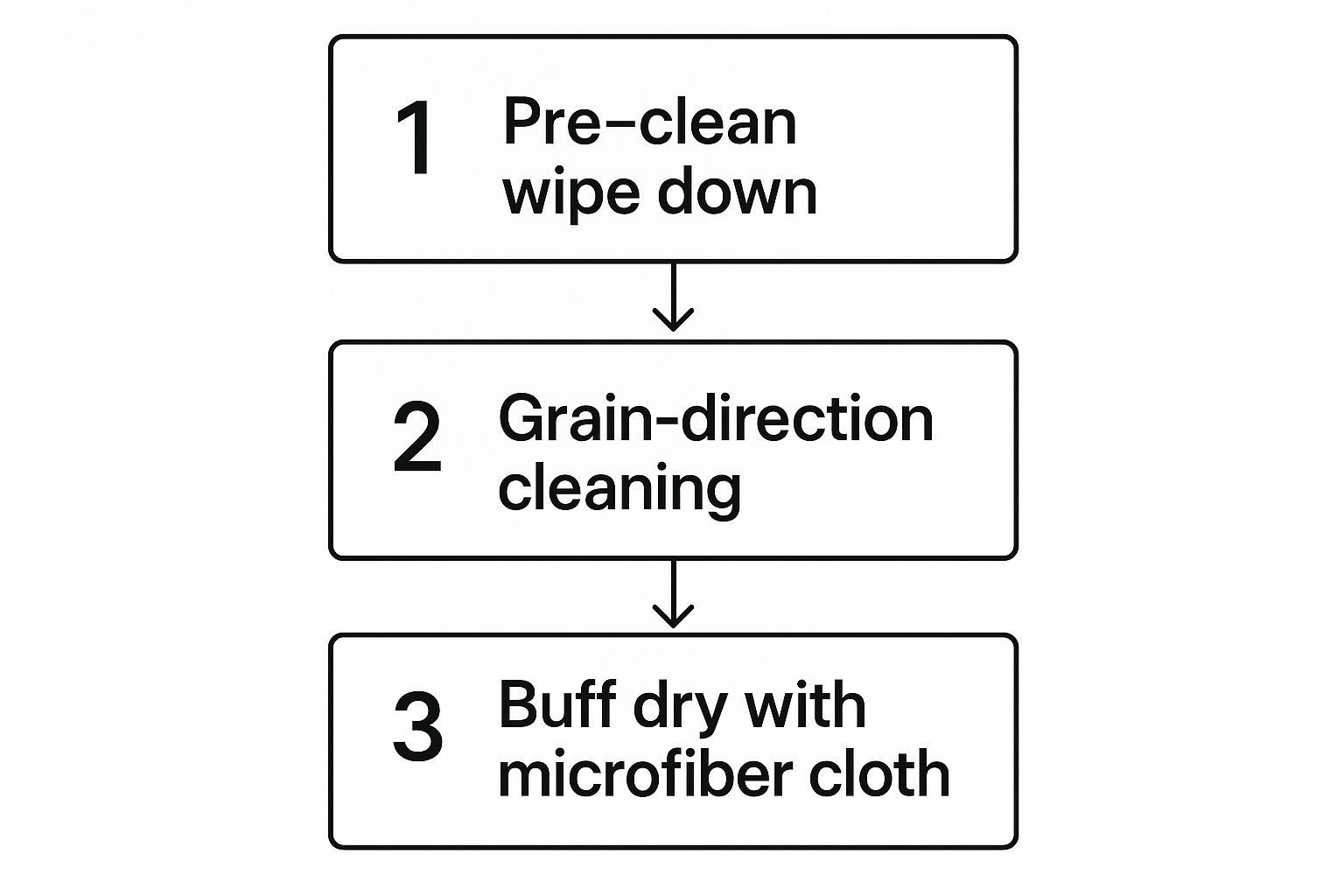
As you can see, it’s a simple sequence: a quick prep wipe, cleaning with the grain, and a meticulous buff-dry to polish the surface and banish any streaks.
Tackling Tough Stains and Everyday Grime
Even with the best daily cleaning habits, commercial kitchen equipment is bound to get hit with some tougher messes. You know the ones I'm talking about—the greasy fingerprints from a busy line cook, the hard water drips that leave chalky streaks, or that mystery splatter that's been there since last night's dinner rush.
When these stubborn spots pop up, it’s easy to think you need to reach for harsh chemicals, but you really don't. In fact, some of the most effective, battle-tested remedies are probably already in your pantry, and they won't risk damaging that expensive stainless steel finish.
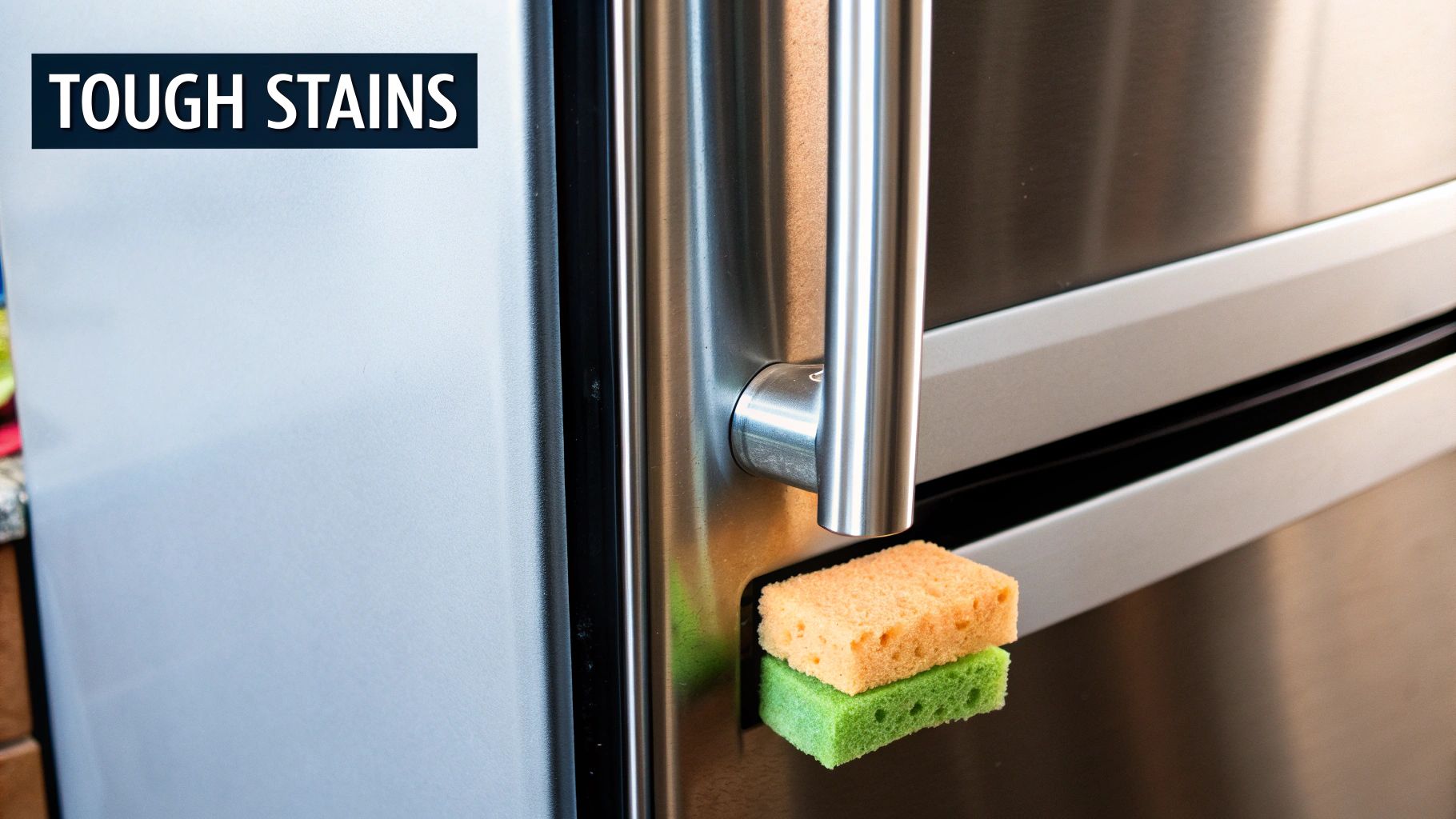
The trick is to start gently and only ramp up your efforts if the stain puts up a fight.
Simple Fixes for Common Problems
When soap and water just aren't cutting it, these simple solutions are my go-to for specific types of grime.
-
For Dried-On Food & Sticky Messes: A baking soda paste works wonders. Just mix a little baking soda with a few drops of water until it’s thick, almost like toothpaste. Dab it onto the stain, let it work its magic for a few minutes, then gently scrub with a damp cloth, always moving with the grain of the steel. It’s just abrasive enough to lift the gunk without scratching the surface.
-
For Hard Water Spots: Those annoying white marks are just mineral deposits left behind by evaporated water. White vinegar is your best friend here. Its natural acidity breaks down those deposits effortlessly. Just put a little vinegar on a microfiber cloth, wipe the area (following the grain!), and then rinse with a clean, water-dampened cloth. The key is to buff it completely dry afterward to stop new spots from forming.
Pro Tip: Before you try any new cleaning method, always test it on a small, hidden spot first—like the bottom edge of the door. This little precaution can save you from accidentally discoloring or damaging the finish.
What about bigger issues, like a surface scratch or—even worse—a bit of rust? Minor scuffs can sometimes be buffed out with a specialized non-abrasive polish, but rust is a different beast entirely. It requires a specific approach to remove it without causing more damage.
For a detailed walkthrough on that, see our guide on how to get rust off a stainless steel fridge. Getting it right is crucial for keeping your equipment in top shape for years to come.
Keeping That Shine: A Simple Maintenance Routine
A big, deep clean is great, but it’s the day-to-day upkeep that really keeps your stainless steel refrigerator looking its best. In the chaos of a commercial kitchen, a simple, consistent cleaning schedule is your secret weapon against grime. It's all about being proactive to save yourself a ton of scrubbing later on.
The easiest win? A quick daily wipe-down. Make it part of your end-of-day closing duties. Just have a team member grab a damp microfiber cloth and wipe away any fresh fingerprints and smudges from the service. This literally takes a minute and stops those oily marks from setting in.
A Weekly Polish for a Lasting Gleam
Once a week, you'll want to give the doors a bit more attention. This is when you'll use your go-to cleaning solution—whether that’s a bucket of warm, soapy water or a dedicated commercial cleaner—to give the surface a proper cleaning. Don't forget to always wipe with the grain to avoid any streaks or fine scratches.
Here's a pro tip: a protective finish is your best friend. After your weekly clean, apply a super thin layer of food-grade mineral oil or a good stainless steel polish. This creates an invisible barrier that actually repels fingerprints and makes those daily wipe-downs even quicker.
This little routine is just one piece of the puzzle. To see how it fits into a bigger strategy for keeping all your gear in top shape, check out our guide on commercial kitchen equipment maintenance.
Finally, get your team on board. A little training goes a long way. Encourage everyone to use the door handles instead of just pushing on the stainless steel surface. It’s a tiny change in habit that dramatically cuts down on the number of smudges you have to clean, keeping your refrigerator looking as sharp as your kitchen's reputation.
Even pros who spend their days in a commercial kitchen have questions about keeping their stainless steel gear looking sharp. It makes sense—when you've sunk a small fortune into your equipment, you want to keep it pristine. Let's tackle some of the most common questions we get about cleaning stainless steel refrigerator doors.
What About Those Super Tough, Caked-On Messes?
A question that comes up all the time is about tackling stubborn grime. Can you just grab an abrasive cleaner and go to town? The answer is a hard no. Anything like steel wool, scouring powders, or cleaners with harsh chlorides will leave behind permanent scratches, dulling the finish for good.
A much better approach for tough spots is a simple paste of baking soda and water. It provides just enough gentle abrasion to lift the grime without damaging the steel itself. It’s a surprisingly effective trick.
Is Glass Cleaner a Safe Shortcut?
It's tempting to grab the glass cleaner for a quick spritz and wipe, especially for smudges and fingerprints. While you can do this in a pinch, there's a big "but" to consider. Most standard glass cleaners contain ammonia, which can strip away the protective layer on your stainless steel over time, leading to discoloration.
If you must use a glass cleaner, hunt down an ammonia-free version and always test it on a hidden spot first. Honestly, for daily smudges, a microfiber cloth with a little warm, soapy water is your best and safest bet.
The real secret isn't some magic cleaner; it's consistency. A quick wipe-down every day is infinitely better for your equipment than a harsh, deep scrub once a week. Gentle, regular care is what preserves that professional finish.
How Can I Stop Fingerprints from Showing Up in the First Place?
This is the holy grail for anyone with stainless steel. To keep those high-traffic fridge doors looking clean, you can create a protective barrier. After a good cleaning, apply a very thin coat of food-grade mineral oil or a dedicated stainless steel polish.
Buff it in well with a clean, dry cloth. This barrier makes it much harder for oils and smudges from hands to stick, which means less time spent cleaning for your crew.
For top-tier new and used equipment that can handle the rigors of a professional kitchen, trust Encore Seattle Restaurant Equipment. Check out our huge selection and find what your business needs at our extensive inventory.
